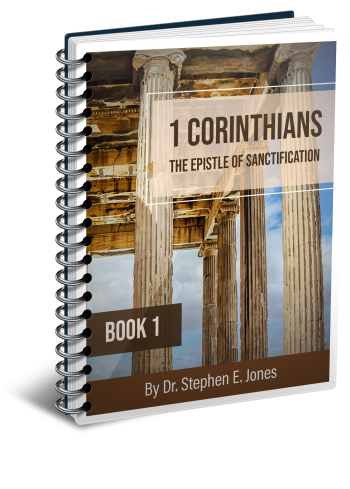Latest Posts
View the latest posts in an easy-to-read list format, with filtering options.

An in-depth commentary/study on the first 6 chapters of First Corinthians.
Category - Bible Commentaries

The Apostle Paul made four missionary journeys before his martyrdom in Rome in 67 A.D. It was on his second missionary journey (51-53 A.D.) that Paul went to Corinth and remained there for eighteen months, establishing a strong church. Paul spent most of his time in Corinth during this missionary journey.
Near the beginning of his second missionary journey, he had met Timothy, whose father was a Jew and whose mother was a Greek. Timothy accompanied Paul and Luke on their journey to Troas (Old Troy) on the coast. There Paul had a night vision (probably a dream), mentioned in Acts 16:9-12,
9 And a vision appeared to Paul in the night; a certain man of Macedonia was standing and appealing to him, and saying, “Come over to Macedonia and help us.” 10 And when he had seen the vision, immediately we sought to go into Macedonia, concluding that God had called us to preach the gospel to them. 11 Therefore putting out to sea from Troas, we ran a straight course to Samothrace, and on the day following to Neapolis; 12 and from there to Philippi, which is a leading city of the district of Macedonia, a Roman colony….
This was how Paul and Silas came to Macedonia and Greece to preach the gospel. In Philippi they met Lydia (Acts 16:14), in whose house they set up the Philippian church. Their ministry was so successful that an idolatrous mob attacked Paul, beat Paul and Silas, and induced the magistrates to throw them into prison. An earthquake later shook the foundations of the prison while they were praising God and singing hymns, and even their chains fell away (Acts 16:26).
The jailor and his family then were converted, and they joined the little fellowship in Philippi. Paul refused to escape the prison, for he did not want to remain in hiding as a wanted man. So he informed them that he was a Roman citizen and that he had been beaten unlawfully. He insisted that the magistrates come to the prison and set him free in a public manner (Acts 16:37).
Paul and his company then went to Thessalonika, where the Jews accused them, “saying that there is another king, Jesus” (Acts 17:7). In their hearing before the city authorities, Paul and Silas were required to state under oath that they were not being seditious. Upon their release, the brethren that night sent them to Berea, where they found a synagogue that was willing to search the Scriptures, rather than just reject the gospel outright.
But when the more fanatical Jews in Thessalonika heard that Paul was in Berea, they sent representatives to Berea to agitate the people against the gospel. The believers then sent Paul and Silas hastily on the first ship leaving Berea. It was heading for Athens, so that is how Paul got to Athens.
Athens was a city of Greek culture and philosophy. At a public place called Areopagus, or “Mars Hill,” Paul found an opportunity to discuss philosophy. His topic is recorded in Acts 17:21-32, where he cited Aratus, a Greek philosopher who lived about 270 B.C. However, Paul received a cold reception to his belief in the resurrection of the dead. Even so, he made some converts in Athens, including “Dionysius the Areopagite and Damaris and others” (Acts 17:34).
From Athens, Paul and his company went to Corinth (Acts 18:1), where he was much more successful. There he met Aquila and Priscilla, who had just left Rome after the Emperor Claudius had issued an edict in 52 A.D. expelling all Jews from Rome. Paul’s greatest success, however, came when the ruler of the Corinthian synagogue believed the gospel (Acts 18:8).
His name was Crispus. It appears that the majority of those in that synagogue did not follow the example of their leader. Crispus was forced to resign his position as leader of the synagogue. His replacement, Sosthenes, opposed the gospel and accused Paul before Gallio, the proconsul of Achaia (Acts 18:12, 17).
But Crispus was not alone in accepting Jesus. Titius Justus was converted. By his Latin name, it appears that he had been a Roman proselyte to Judaism. His house was next door to the synagogue.
Gallio, the proconsul, was the brother of the Roman philosopher, Seneca. In 49 A.D. Seneca had been brought back from exile in order to become Nero’s tutor. So Gallio was a man of great influence and power. He acquitted Paul, realizing that this was a religious dispute within Judaism itself and had nothing to do with sedition or any violation of Roman or Greek laws. He even allowed the crowd to beat Sosthenes as punishment for falsely accusing Paul (Acts 18:17).
Luke is silent on any further contact with Gallio, but since we find Paul later corresponding with Seneca, it is likely that Gallio provided that introduction. Paul’s earlier studies in the philosophies of the day gave him the knowledge to discuss philosophy with Seneca, the Stoic.
After eighteen months of teaching in Corinth, a strong church was established. Paul then crossed the sea to Ephesus and then to Antioch (Acts 18:22), where he gave his report to the church that had laid hands on him to send him on his missionary journeys.
When Paul went to Corinth, it was the most important city in Greece. Though Athens surpassed Corinth in culture, history, and schools of philosophy, Corinth was more important as a political and commercial center. Corinth was the capital of the Roman province of Achaia. Its commercial importance was due to its location on the narrow isthmus (channel) connecting the Peloponnesus with the Greek mainland.
The isthmus connected the Ionian Sea on the western side with the Aegean Sea on the eastern side. Hence, Corinth was known as “The City of the Two Seas,” located on the main trade route between Asia and Rome. The city had been destroyed in 146 B.C. by Lucius Mummius Achaicus, the Roman general who brought all of Greece under Roman domination in the second century B.C. But the city’s location was too important to remain in ruins, and a century later Julius Caesar reconstructed it in 46 B.C. and gave it the status of a Roman colony. It soon regained and surpassed its former, splendor, population, and wealth.
It was a saying in Paul’s day that if one lived in luxury and licentiousness, he was “living as a Corinthian.” When men planned huge banquets, they would call them “Corinthian banquets.” They also used the phrase “Corinthian drinkers” much like we would talk about “drunken sailors.” In any Greek play, a Corinthian character always entered the stage drunk. Further, “to act Corinthian” was to practice fornication, and as Moffatt wrote, “Every Greek knew what a ‘Corinthian girl’ meant.” The city was noted for its depravity.
Old Corinth, before its destruction in 146 B.C., had been the site of the famous Temple of Aphrodite, which had a thousand sacred prostitutes. Essentially, the temple had a monopoly on prostitution. Though the city was destroyed, the spirit of Aphrodite remained, for the land was never cleansed, nor was this spirit expelled. Paul, writing to the church from Ephesus, found himself having to deal with moral issues, and hence, this is the epistle of sanctification.
Corinth was probably the fourth largest city in the Roman Empire, and when it was rebuilt, it was colonized mostly by Roman freedmen. Hence, politically and ethnically, the city was Roman, but the culture was Greek. So we find Titius Justus among Paul’s converts, a Roman proselyte to Judaism in a city of Greek culture.
Half of the city’s population were made up of slaves. Because of its location on a main trade route, the city had attracted people of many ethnicities, making it a cosmopolitan city as well. Among its inhabitants were Jews, and so there was a large synagogue in Corinth, led for a time by Crispus, where Paul preached the gospel.
In many ways Corinth was like a mini-Roman Empire and has been called “the Empire in miniature—the Empire reduced to a single State.”
What we know as First Corinthians was actually Paul’s second letter to that church. The first one was either lost or, more probably, Paul decided not to include it in the letters to be canonized as Scripture. His first letter is mentioned in 1 Cor. 5:9. Toward the end of Paul’s life, as he was preparing for martyrdom, the apostle sent for Timothy, asking him to “bring the cloak which I left at Troas with Carpus, and the books, especially the parchments” (2 Tim. 4:13).
This was not an overcoat to keep Paul warm, but rather, the cloak was a phelonen, a wrapper to shield parchments from the elements. It was the leather case in which Paul’s original letters were kept. Paul needed to look them over, pray over them, and perhaps edit them for the last time. He then sent them to John in Ephesus, who was called to hold the official copies of Paul’s writings for inclusion in the New Testament.
John was the final writer of New Testament writings and was the steward of Paul’s original letters to be used in the canon. I wrote about this further in my book, Lessons from Church History, Vol. 1, chapters 23 and 24.
It is clear that Paul’s first letter to the Corinthians was not included in the canon. Paul wrote other letters as well, which were not included in the canon. We cannot assume that these were simply “lost,” but that Paul had specified which of his letters should be included and which should not be included.
Nonetheless, when reading Paul’s letters to the Corinthians, it is important to know that he was often answering their letters to him—letters that are now lost. He often refers to those letters (and questions), quoting from them directly. As we will see, some of those occasions where he was quoting their letters, make it appear that those quotes were actually Paul’s own teachings. However, that is not the case. After quoting those things which Paul was disputing, he usually refuted them immediately, beginning with: “What? Do you not know…”
Such a statement shows that Paul was surprised that anyone could believe such teaching. Yet if we do not know that he was quoting from or referring to their teachings, we may think that Paul himself was teaching these things, when in fact he was refuting those ideas. We will deal with those issues in due time when they arise during our study of Paul’s letters.